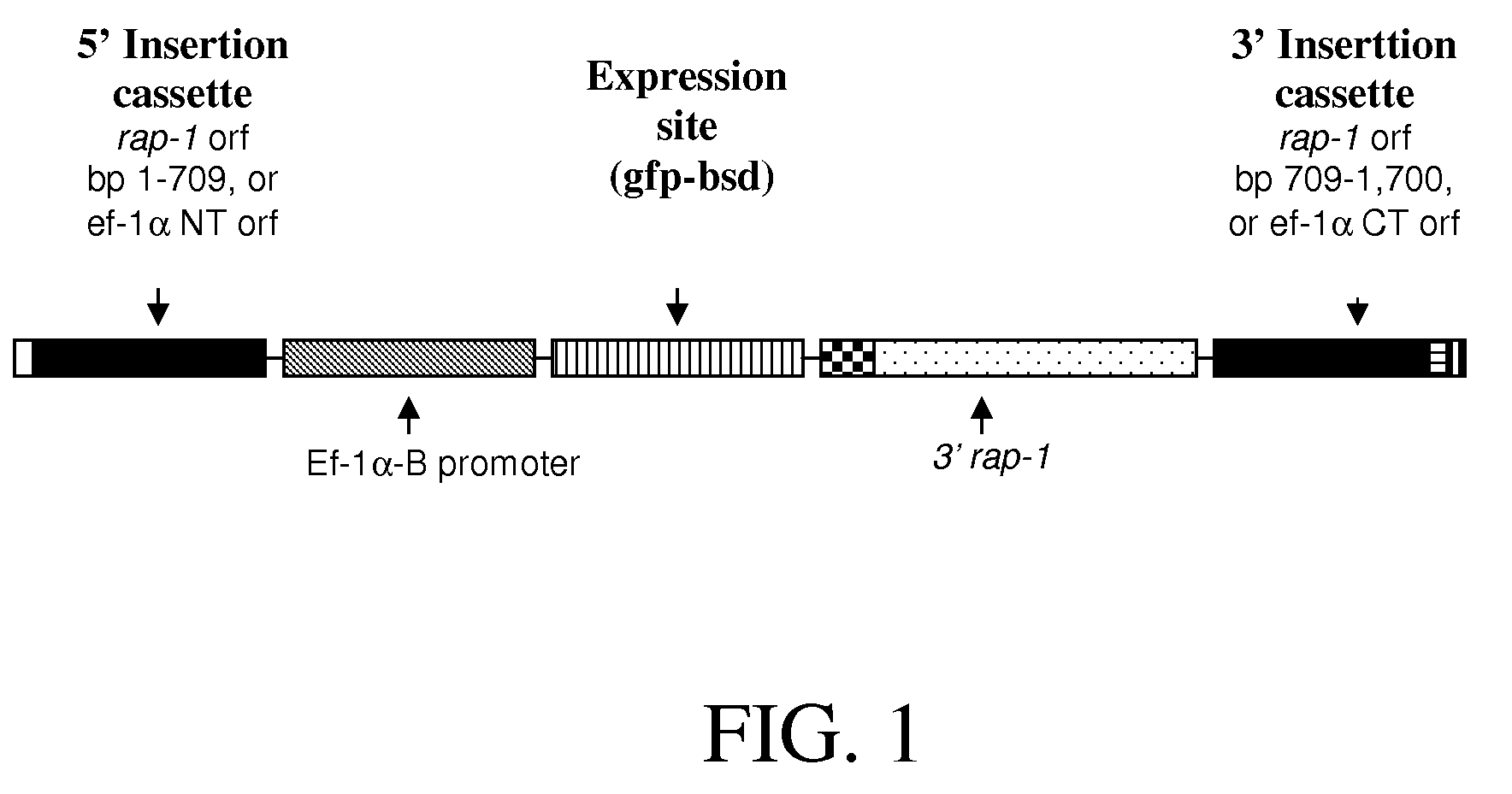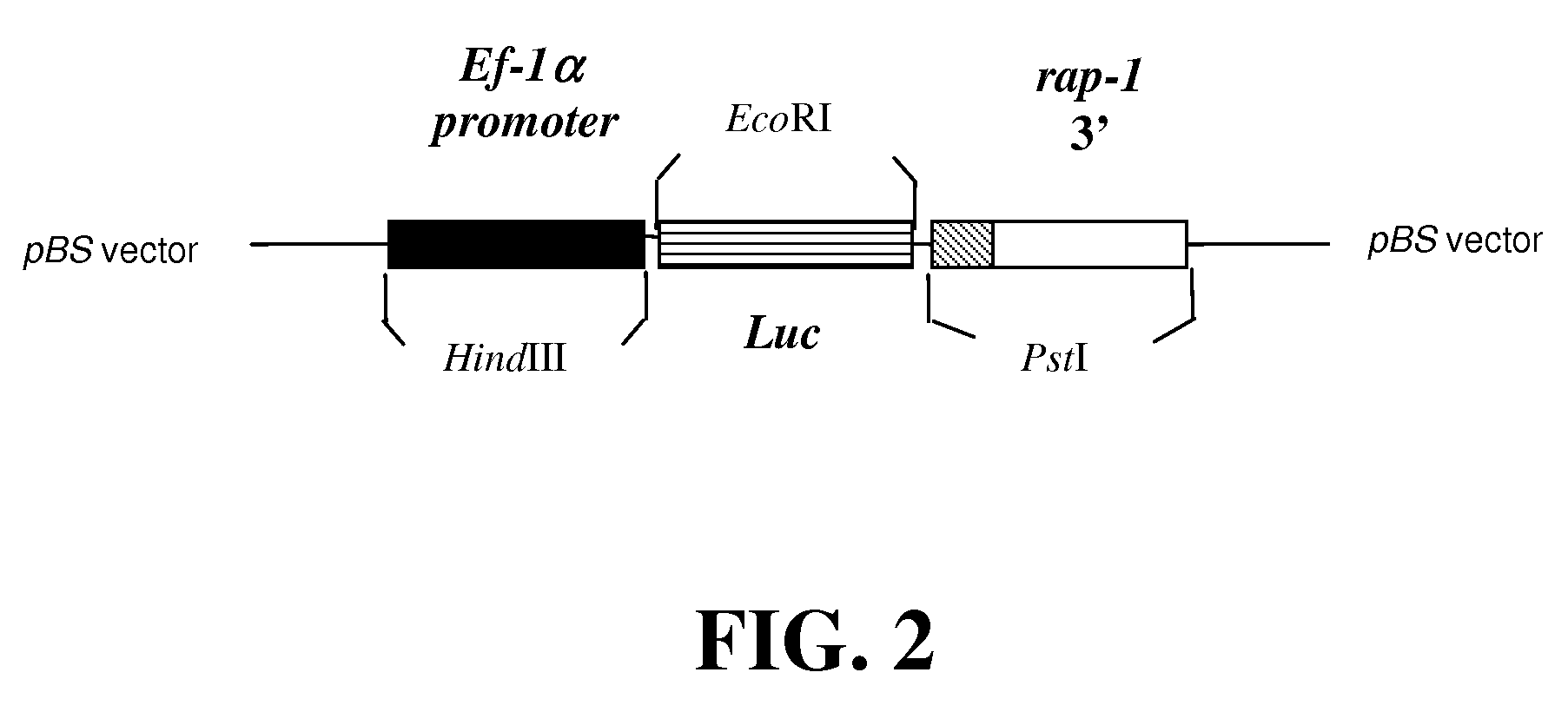Genetically modified Babesia parasites expressing protective tick antigens and uses thereof
a technology of parasites and antigens, applied in the field of vaccines, can solve the problems of economic loss associated with ticks, ticks are particularly problematic and harmful, parasitic arthropods and diseases they transmit are a global problem, and achieve the effect of stable transfection of babesia parasites
- Summary
- Abstract
- Description
- Claims
- Application Information
AI Technical Summary
Benefits of technology
Problems solved by technology
Method used
Image
Examples
example 1
[0113]The following example illustrates exemplary methods for obtaining Babesia transfectants for use in the preparation of vaccines that protect against ticks and that may also protect against Babesia.
Materials and Methods
[0114]Parasites:
[0115]The Mo7 biological clone of B. bovis was derived by limiting dilution of the Mexico strain as described (Rodriguez et al, (1983) Infect Immun. 42:15-18; Hines et al. (1989) Mol. Biochem. Parasitol. 37: 1-10), and was maintained as a cryopreserved stabilate in liquid nitrogen (Palmer et al., (1982) Parasitology. 84:567-571). Parasites were grown in long term microaerophilous stationary-phase culture by previously described techniques (Levi and Ristic, (1980) Science. 207:1218-1220; and Hines et al., (1989) supra). B. bovis purified merozoites were obtained from 8 to 10-flask expansion of B. bovis typically containing between 30-40% infected red blood cells (iRBC) as determined by microscopic counting of Giemsa stained slides, as described pre...
example 2
[0128]The following example illustrates an exemplary method for the preparation Babesia parasites stably transfected with a heterologous nucleic acid. In one exemplary embodiment, stable transfection systems for Babesia are useful for functional analysis of the recently sequenced Babesia bovis genome (Brayton K. A., et al. supra). In addition, the ability stably transfect Babesia cells allows one of skill to knock out specific genes and to express transgenes. In exemplary embodiments stably transfected Babesia parasites are exploited for the development of attenuated Babesia vaccine strains co-expressing foreign genes as immunogens. In some exemplary embodiments, markers are also introduced into stable transfectant cell lines that can be used to identify vaccinated animals.
[0129]FIG. 4 illustrates the structure of plasmid p4-35-ef-luc. The restriction sites used for linearization (KpnI) and double digestion (KpnI and NotI) are indicated with arrows.
[0130]Nucleofection and electropor...
example 3
[0133]The following example illustrates stable integration of plasmid DNA into the genome of Babesia bovis using blasticidin / blasticidin deaminase selection.
[0134]Blasticidin / blasticidin deaminase selection has been shown to work with other protozoa. Furthermore no known bsd gene is present in the B. bovis genome. Thus, the occurrence of resistant strains that are not transfected with the plasmid is reduced. Blasticidin proved to be an efficient inhibitor of the growth of B. bovis with an IC50 of ˜0.4 μg / ml, a drug concentration comparable to the IC50 (0.35 μg / ml) calculated for Plasmodium falciparum parasites. In addition, a gfp / bsd fusion gene was used to incorporate an additional marker of expression. With this construct, blasticidin resistant parasites emerged relatively quickly after selection. The blasticidin-resistant transfected B. bovis parasites are able to grow in high concentrations of blasticidin with growth curves that are similar to non-selected parasites in the absen...
PUM
| Property | Measurement | Unit |
|---|---|---|
| Tm | aaaaa | aaaaa |
| temperature | aaaaa | aaaaa |
| temperature | aaaaa | aaaaa |
Abstract
Description
Claims
Application Information
 Login to View More
Login to View More - R&D
- Intellectual Property
- Life Sciences
- Materials
- Tech Scout
- Unparalleled Data Quality
- Higher Quality Content
- 60% Fewer Hallucinations
Browse by: Latest US Patents, China's latest patents, Technical Efficacy Thesaurus, Application Domain, Technology Topic, Popular Technical Reports.
© 2025 PatSnap. All rights reserved.Legal|Privacy policy|Modern Slavery Act Transparency Statement|Sitemap|About US| Contact US: help@patsnap.com



